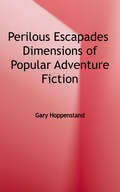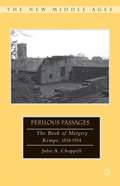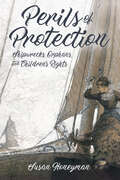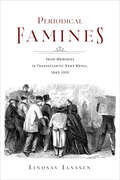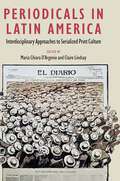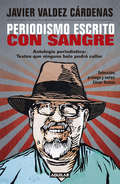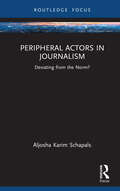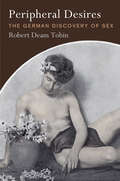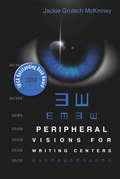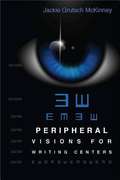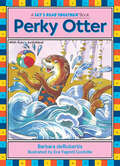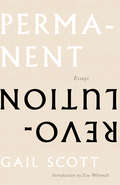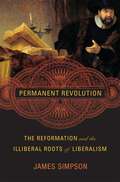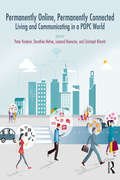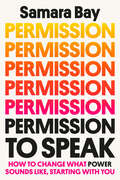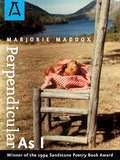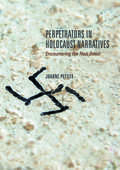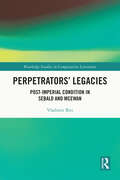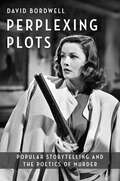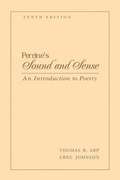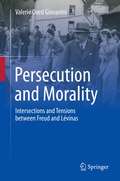- Table View
- List View
Perilous Escapades: Dimensions of Popular Adventure Fiction
by Gary HoppenstandAdventure fiction is one of the easiest narrative forms to recognize but one of the hardest to define because of its overlap with many other genres. This collection of essays attempts to characterize adventure fiction through the exploration of key elements--such as larger-than-life characters and imperialistic ideas--in the genre's 19th- and 20th-century British and American works like The Scarlet Pimpernel by Orczy and Captain Blood by Sabatini. The author explores the cultural and literary impact of such works, presenting forgotten classics in a new light.
Perilous Passages
by Julie A. ChappellOn December 27, 1934, the American scholar Hope Emily Allen announced in The Times the reappearance of a late medieval manuscript called The Book of Margery Kempe. Perilous Passages: The Book of Margery Kempe, 1534-1934 explores the various paths by which this late medieval manuscript made its way out of a monastery in Yorkshire during Henry VIII's religious reformation to the home of a family of deep English and Catholic roots in the twentieth century. Julie A. Chappell reveals new evidence that implicates the Carthusians as conscious preservers of this manuscript between 1534 and 1537 and significantly furthers our understanding of the ways in which the unique autobiography of Margery Kempe, lay woman turned mystic and visionary, was interpreted. Most importantly, this fascinating study bridges the gaps in our understanding of the transmission of texts from the medieval past to the present.
Perilous Passions: Ethics and Emotion in Early Modern Spain (Toronto Iberic #87)
by Hilaire KallendorfCan feelings be wrong? Scientists agree that emotions contain both a cognitive and a physiological component. The cognitive part can be modified, while the physiological response is largely involuntary. In religious terms, the answer is clear in its legislation of heart motives: love your enemies, lust is equivalent to adultery, hate is the same thing as murder. In Perilous Passions, Hilaire Kallendorf draws on early modern Spanish theatre to reveal how emotions have always been understood as central to ethics. Starting with a treatise on emotion, On the Passions of the Soul by Juan Luis Vives (1493–1540), Kallendorf uses pairs of opposing emotions – love/hatred, desire/aversion, joy/sorrow, hope/despair, and courage/fear – to explore how they are depicted in Golden Age plays. The book pinpoints and probes intersections of feelings with morality. It asks: Do emotions bear positive or negative ethical overtones? Which emotions are more conducive to virtue? Are passions perceived as perilous in early modern Spain, in agreement with Neostoic principles? Or does the Catholic liturgy’s emphasis on involving the corporeal senses in worship mean that bodily sensations, including feelings, are accorded pride of place – especially in drama? In asking these questions, Perilous Passions argues for the significance of theatre in emotional education.
Perilous Realms
by Marjorie J. BurnsJ.R.R. Tolkien (1892-1973) is increasingly recognized as the most influential writer of the twentieth century. Sales of his books remain exceptionally high, and Middle-earth fan clubs flourish around the world. The massive success of the film versions made of The Lord of the Rings, and released between 2001 and 2003, have only added to his popularity.Throughout his life, Tolkien was acutely aware of the power of myth in shaping society; so much so, that one of his earliest ambitions as a writer was to create a mythology for England. The Middle-earth of The Lord of the Rings and The Hobbit was to serve as a stand-in for Britain and North-western Europe and is strongly based on a variety of influential literatures and beliefs, particularly the Celtic and Norse. Perilous Realms is the first book to focus consistently on the ways in which Tolkien balances these two ancient cultures and unites them in a single literature. Renowned Tolkien scholar Marjorie Burns also investigates the ways Tolkien reconciled other oppositions, including paganism and Christianity, good and evil, home and wayside, war and peace, embellishment and simplicity, hierarchy and the common man.Even those who do not know Beowulf or the Arthurian tales or northern European mythology come away from The Lord of the Rings with a feeling for Britain's historical and literary past. Those who recognize the sources behind Tolkien - and the skill with which he combines these sources - gain far more. Perilous Realms gives this advantage to all readers and provides new discoveries, including material from obscure, little-known Celtic texts and a likely new source for the name 'hobbit.' It is truly essential reading for Tolkien fans.
Perils of Protection: Shipwrecks, Orphans, and Children's Rights (Children's Literature Association Series)
by Susan HoneymanWinner of the Children’s Literature Association’s 2020 Honor Book AwardUnrecognized in the United States and resisted in many wealthy, industrialized nations, children’s rights to participation and self-determination are easily disregarded in the name of protection. In literature, the needs of children are often obscured by protectionist narratives, which redirect attention to parents by mythologizing the supposed innocence, victimization, and vulnerability of children rather than potential agency.In Perils of Protection: Shipwrecks, Orphans, and Children's Rights, author Susan Honeyman traces how the best of intentions to protect children can nonetheless hurt them when leaving them unprepared to act on their own behalf. Honeyman utilizes literary parallels and discursive analysis to highlight the unchecked protectionism that has left minors increasingly isolated in dwindling social units and vulnerable to multiple injustices made possible by eroded or unrecognized participatory rights.Each chapter centers on a perilous pattern in a different context: “women and children first” rescue hierarchies, geographic restriction, abandonment, censorship, and illness. Analysis from adventures real and fictionalized will offer the reader high jinx and heroism at sea, the rush of risk, finding new families, resisting censorship through discovering shared political identity, and breaking the pretenses of sentimentality.
Periodical Famines: Irish Memories in Transatlantic News Media, 1845–1919 (Irish Culture, Memory, Place)
by Lindsay JanssenLong recognized as Ireland's greatest demographic disaster in recent history, the Great Famine of 1845–1851 has shaped Irish identities around the world. From the monuments erected to commemorate its victims to the political rhetoric involving it to the novels, poems, songs, and films that it continues to inspire, the Famine remains a crucial part of Irish memory. Famine memories have also reached across history and national borders to establish links with cultural groups who were not directly connected to the Irish diaspora.Periodical Famines reveals how, within the transatlantic Irish periodical market between 1845 and 1910, Irish, Irish American, and Irish Canadian newspapers and magazines acted as carriers and shapers of cultural identities. Lindsay Janssen argues that famine memory was deployed transhistorically to help represent other crucial events in the Irish past, and periodicals used Famine recollections transnationally to give new meaning to events outside of Ireland, such as labor issues in the United States and the Second Boer War. Moving beyond individual writings to interrogate how different texts printed within a periodical issue influenced each other and affected audiences' attitudes to Irish hunger and distress, Janssen's cotextual approach reveals the intricate and sometimes divergent paths that Famine memory traveled through in the decades during and after its onset.Drawing upon a substantial corpus of creative and nonfiction periodical publications (including nearly 600 works of poetry and prose fiction), Periodical Famines is a thorough analysis of transatlantic Irish periodical culture during and after the Great Famine, demonstrating how periodicals' transmission of famine memories shaped global cultures.
Periodicals in Latin America: Interdisciplinary Approaches to Serialized Print Culture (Reframing Media, Technology, and Culture in Latin/o America)
by Claire Lindsay Maria Chiara D'ArgenioExploring how Latin American print culture has informed global exchange The first volume in English to focus on Latin American serialized print culture, Periodicals in Latin America assembles research on a diverse range of publications, including avant-garde reviews, comics, specialized journals, mass-market magazines, and political periodicals, from the late nineteenth century to the present day. In this book, scholars from a variety of disciplines examine both celebrated and little-known periodicals to demonstrate how publications supported emerging movements such as Indigenismo and feminism; undermined hegemonic conceptions of statehood and national identity; and questioned ideas about the relationship between the visual, literary, and political. Bringing Latin American print culture together with research and theories from the largely Anglophone field of periodical studies, this volume contests readings that discount the region’s periodicals, situating Latin America as a contributor to—not just a recipient of—global exchanges. Contributors also challenge the idea that periodicals are only useful for the insights they can offer into history, championing close attention to their material and materiality. The writers in this book reflect on the unique qualities and divergences of the region’s periodicals from those of other parts of the world and the need for different approaches to studying them. The volume bridges and brings into dialogue new research on print serials and their readers in the Spanish-, Portuguese-, and English-speaking worlds. Contributors: Joanna Crow | María del Pilar Blanco | José Chávarry | Jorge Catalá | Isabella Cosse | M. Paula Bontempo | Sandra Szir | Camilla Sutherland | Luis Rebaza-Soraluz | Claire Lindsay | Valentino Gianuzzi | Sofía Mercader | Rielle Navitski | Luz Ainaí Morales Pino | Maria Chiara D’Argenio A volume in the series Reframing Media, Technology, and Culture in Latin/o America, edited by Héctor Fernández L’Hoeste and Juan Carlos Rodríguez
Periodismo escrito con sangre
by Javier Valdez CárdenasPeriodismo escrito con sangre es un homenaje al periodista ejecutado por decir la verdad, por dar voz a los desposeídos, a quienes tienen en el rostro la herida viva, ardiente, ocasionada por el crimen organizado y la indiferencia o complicidad de las autoridades. Selección, prólogo y notas: César Ramos. El 15 de mayo de 2017 fue asesinado en Culiacán el periodista Javier Valdez Cárdenas, autor de una serie de libros excepcionales para entender el fenómeno del narco y el voraz crecimiento de la delincuencia organizada en México. Periodista valiente y puntual, crítico hasta el extremo con la realidad de nuestro país, su trabajo logró reconocimiento internacional y, sobre todo, por una pluma vibrante, conmovedora, profundamente humana. Se recogen en este libro trabajos de sus libros Miss Narco, Los morros del narco, Levantones, Con una granada enla boca, Huérfanos del narco y Narcoperiodismo. Hay un denominador común en las crónicas, investigaciones y reportajes de Valdez Cárdenas: su acercamiento intenso al ser humano, a las madres muertas en vida por no saber de sus hijos; al adicto que mira derrumbarse toda ilusión en un escenario de violencia impasible; a la víctima del levantón, del ejercicio terrible del sicario; al policía baleado; al niño despojado de toda esperanza en una casa donde se come desgracia; a las jóvenes que cambiaron la ilusión por el infierno del narco, el glamour por la ejecución feroz en un baldío. Queda claro que Javier Valdez Cárdenas vive ahora en sus escritos y justo, imprescindible, es leer su trabajo periodístico porque esa voz no será apagada jamás por ningún balazo.
Peripheral Actors in Journalism: Deviating from the Norm? (Routledge Focus on Journalism Studies)
by Aljosha Karim SchapalsThis book addresses the transformative role that so-called peripheral actors in journalism – emerging outlets diverging from the norms fiercely held by mainstream media outlets – play in today’s news ecosystem. The author charts the rise to prominence of these actors, outlining how they have successfully managed to challenge the authority held by mainstream, legacy outlets, whose claims to be the “storytellers of our time” no longer exclusively pertain to them. Beginning by identifying these peripheral actors specifically, the book then considers whether what they do is “journalism” as traditionally conceived, what their motivations are, and why their role is important in light of journalism’s democratic function in holding power to account. Ultimately, it is argued that, despite the perceived role of peripheral actors as “deviant”, they still demonstrate a surprising degree of ideological continuity in the face of industrial disruption. Drawing on research from Australia, Germany, and the United Kingdom, Peripheral Actors in Journalism is an insightful resource for journalism and media scholars with an interest in alternative media sources.
Peripheral Desires: The German Discovery of Sex (Haney Foundation Series)
by Robert Deam TobinIn Peripheral Desires, Robert Deam Tobin charts the emergence, from the 1830s through the early twentieth century, of a new vocabulary and science of human sexuality in the writings of literary authors, politicians, and members of the medical establishment in German-speaking central Europe—and observes how consistently these writers, thinkers, and scientists associated the new nonnormative sexualities with places away from the German metropoles of Berlin and Vienna.In the writings of Aimée Duc and Lou Andreas-Salomé, Switzerland figured as a place for women in particular to escape the sexual confines of Germany. The sexual ethnologies of Ferdinand Karsch-Haack and the popular novels of Karl May linked nonnormative sexualities with the colonies and, in particular, with German Samoa. Same-sex desire was perhaps the most centrifugal sexuality of all, as so-called Greek love migrated to numerous places and peoples: a curious connection between homosexuality and Hungarian nationalism emerged in the writings of Adalbert Stifter and Karl Maria Kerbeny; Arnold Zweig built on a long and extremely well-developed gradation of associating homosexuality with Jewishness, projecting the entire question of same-sex desire onto the physical territory of Palestine; and Thomas Mann, of course, famously associated male-male desire with the fantastically liminal city of Venice, lying between land and sea, Europe and the Orient.As Germany—and German-speaking Europe—became a fertile ground for homosexual subcultures in the nineteenth and early twentieth centuries, what factors helped construct the sexuality that emerged? Peripheral Desires examines how and why the political, scientific and literary culture of the region produced the modern vocabulary of sexuality.
Peripheral Visions for Writing Centers
by Jackie Grutsch McKinneyPeripheral Visions for Writing Centers aims to inspire a re-conception and re-envisioning of the boundaries of writing center work. Moving beyond the grand narrative of the writing center—that it is solely a comfortable, yet iconoclastic place where all students go to get one-to-one tutoring on their writing—McKinney shines light on other representations of writing center work. McKinney argues that this grand narrative neglects the extent to which writing center work is theoretically and pedagogically complex, with ever-changing work and conditions, and results in a straitjacket for writing center scholars, practitioners, students, and outsiders alike. Peripheral Visions for Writing Centers makes the case for a broader narrative of writing center work that recognizes and theorizes the various spaces of writing center labor, allows for professionalization of administrators, and sees tutoring as just one way to perform writing center work. McKinney explores possibilities that lie outside the grand narrative, allowing scholars and practitioners to open the field to a fuller, richer, and more realistic representation of their material labor and intellectual work.
Peripheral Visions for Writing Centers
by Jackie Grutsch MckinneyPeripheral Visions for Writing Centers aims to inspire a re-conception and re-envisioning of the boundaries of writing center work. Moving beyond the grand narrative of the writing center--that it is a solely comfortable, yet iconoclastic place where all students go to get one-on-one tutoring on their writing--Grutsch McKinney shines light on other representations of writing center work.Grutsch McKinney argues that this grand narrative neglects the extent to which writing center work is theoretically and pedagogically complex, with ever-changing work and conditions, and results in a straitjacket for writing center scholars, practitioners, students, and outsiders alike. Peripheral Visions for Writing Centers makes the case for a broader narrative of writing center work that recognizes and theorizes the various spaces of writing center labor, allows for professionalization of administrators, and sees tutoring as just one way to perform writing center work. Grutsch McKinney explores possibilities that lie outside the grand narrative, allowing scholars and practitioners to open the field to a fuller, richer, and more realistic representation of their material labor and intellectual work.
Perky Otter: Vowel Combination Er (Let's Read Together ®)
by Barbara deRubertisLet&’s Read Together books merge rhyme and vowel sounds in delightfully zany stories kids will want to read again and again. Each of the 15 books in this classic series by award-winning author/educator Barbara deRubertis will give your child a jumpstart on reading success."Story lines are silly and inventive, and recall Dr. Seuss&’s Cat in the Hat for the building of rhythm and rhyming words." —School Library JournalPerky Otter and busy Bert the Beaver learn that they have a few things in common after all. (This easy-to-read story features the "er" vowel combination.)
Permanent Revolution: Essays
by Gail ScottWith a Foreword by Zoe Whittall."A writer may do as she pleases with her epoch. Except ignore it," says Gail Scott. Permanent Revolution traces her seminal investigation of prose experiment to the present, including a recreation of the iconic text Spaces Like Stairs, in a collection of essays relating the matter of writing to ongoing social upheaval. "Where there is no emergency there is likely no real experiment," she writes.In conversation with other writers across the continent identified with current queer/feminist avant-garde trajectories, including l’écriture-au féminin moment in Québec, and queer continental New Narrative, Permanent Revolution is an evolutionary snapshot of contemporaneous Fe-male ground-breaking prose.With Permanent Revolution, Scott interrogates her era, twice. Belonging in the canon alongside Maggie Nelson, Lydia Davis and Renee Gladman, Gail Scott is an important feminist thinker of our time.Praise for Permanent Revolution:"Permanent Revolution is written in the gap between what a novel could have been and what is possible now, and that's a kind of grammar. Reading these essays, I felt the part of me that never writes, but longs to, come back to life for a few moments and/or forever." —Bhanu Kapil"I can still remember the thrill of first entering the space of Gail Scott's novel, My Paris, a diary written all in present participles, the way I stumbled along the sentences as if around a city. In these essays we get to travel through Scott's thinking through narrative, gender and queer aesthetics, from philosophizing her own experiments in prose to being in conversation with the écriture feminine of friends, from Nicole Brossard's Mauve Desert to New Narrative. She also writes through her literary foremothers, from Kathy Acker through the trilogy of the "masturbating French dykes" (ha!) (Irigaray, Cixous, Wittig) to Marguerite Duras. It was Duras's nonfiction I thought about when reading Permanent Revolution—profound and poetic, enacting the urgency of literature amidst the emergencies of now." —Kate Zambreno, author of Heroines and Drifts
Permanent Revolution: The Reformation and the Illiberal Roots of Liberalism
by James SimpsonHow did the English Reformation, with its illiberal, intolerant beginnings, lay the groundwork for the Enlightenment—free will, liberty of conscience, religious toleration, constitutionalism, and all the rest? In his provocative rewriting of the history of liberalism, James Simpson uncovers its unexpected debt to Protestant evangelicalism.
Permanently Online, Permanently Connected: Living and Communicating in a POPC World
by Leonard Reinecke Christoph Klimmt Peter Vorderer Dorothée HefnerPermanently Online, Permanently Connected establishes the conceptual grounds needed for a solid understanding of the permanently online/permanently connected phenomenon, its causes and consequences, and its applied implications. Due to the diffusion of mobile devices, the ways people communicate and interact with each other and use electronic media have changed substantially within a short period of time. This megatrend comes with fundamental challenges to communication, both theoretical and empirical. The book offers a compendium of perspectives and theoretical approaches from leading thinkers in the field to empower communication scholars to develop this research systematically, exhaustively, and quickly. It is essential reading for media and communication scholars and students studying new media, media effects, and communication theory.
Permission to Speak: How to Change What Power Sounds Like, Starting with You
by Samara BayUse your voice to lead us to a better future with this game-changing guide to redefining what power and authority sound like—from a speech expert who&’s worked with Hollywood&’s biggest stars, political powerhouses, and businesspeople shaking up the status quo.&“I love this book—funny, surprising, stirring, and so important! What a beautiful accomplishment and gift to put into the world.&”—Rachel McAdamsGetting heard is a tricky business: It&’s what you say and how you show up, filtered through your audience&’s assumptions and biases—and maybe even your own. For women, people of color, immigrants, and queer folks, there&’s often a dissonance between how you speak and how we collectively think powerful people should speak: like the wealthy white men who&’ve historically been in charge. But, fortunately, the sound of power is changing.Permission to Speak is your tool kit for making that change. In this revolutionary take on how to use your voice to get what you want, sought-after speech coach Samara Bay offers a fresh perspective on public speaking and a new definition of what power sounds like: namely, you. Blending anecdotes with eye-opening research in leadership, linguistics, and social science, Permission to Speak shows you how to strike the right balance of strength and warmth to land your message; exactly what to do before a high-stakes scenario so that your voice, your mind, and your spirit are ready; and how to turn habits like vocal fry and upspeak into tools. Most important, you&’ll discover your voice story: why you talk the way you do, what&’s wonderful about it, and what you&’ve outgrown.Fiery, fun, and truly profound, Permission to Speak is a personal and cultural reckoning with what speaking in public is and what it can be. This book meets the moment and offers this provocation: When we change what power sounds like, we change who has it.
Perpetrators in Holocaust Narratives: Encountering the Nazi Beast
by Joanne PettittThis study provides a comprehensive analysis of representations of Holocaust perpetrators in literature. Such texts, often rather controversially, seek to undo the myth of pure evil that surrounds the Holocaust and to reconstruct the perpetrator in more human (“banal”) terms. Following this line of thought, protagonists frequently place emphasis on the contextual or situational factors that led up to the genocide. A significant consequence of this is the impact that it has on the reader, who is thereby drawn into the narrative as a potential perpetrator who could, in similar circumstances, have acted in similar ways. The tensions that this creates, especially in relation to the construction of empathy, constitutes a major focus of this work. Making use of in excess of sixty primary sources, this work explores fictional accounts of Holocaust perpetration as well as Nazi memoirs. It will be of interest to anyone working in the broad areas of Holocaust literature and/or perpetrator studies.
Perpetrators’ Legacies: Post-imperial Condition in Sebald and McEwan (Routledge Studies in Comparative Literature)
by Vladimir BitiThe book presents Winfried Georg Sebald and Ian McEwan as paradigmatic post-imperial writers who enmeshed in the hierarchies of power inherited from their imperial times, strive to disentangle themselves from that burdensome legacy. To achieve this, they undertake a subtle detachment from the analogously implicated subject positions of their protagonists. In Sebald’s works, these positions are closer to the historical victims of the Third Reich who used to suppress their past experiences, whereas in McEwan’s works, they incline toward the systemic ‘beneficiaries’ of the British Empire who used to overlook their present privileges. However, in distinction to their protagonists’ denied involvements, both authors recognize their implication in their protagonists’ pasts and presents. Such a detachment from familiar protagonists requires the consent of unknown and scattered readers with whom they forge a long-distance solidarity, connective association or complicitous alliance. Thus, to exempt themselves from one complicity, they enter another one.
Perplexing Plots: Popular Storytelling and the Poetics of Murder (Film and Culture Series)
by David BordwellNarrative innovation is typically seen as the domain of the avant-garde. However, techniques such as nonlinear timelines, multiple points of view, and unreliable narration have long been part of American popular culture. How did forms and styles once regarded as “difficult” become familiar to audiences?In Perplexing Plots, David Bordwell reveals how crime fiction, plays, and films made unconventional narrative mainstream. He shows that since the nineteenth century, detective stories and suspense thrillers have allowed ambitious storytellers to experiment with narrative. Tales of crime and mystery became a training ground where audiences learned to appreciate artifice. These genres demand a sophisticated awareness of storytelling conventions: they play games with narrative form and toy with audience expectations. Bordwell examines how writers and directors have pushed, pulled, and collaborated with their audiences to change popular storytelling. He explores the plot engineering of figures such as Raymond Chandler, Agatha Christie, Dashiell Hammett, Patricia Highsmith, Alfred Hitchcock, Dorothy Sayers, and Quentin Tarantino, and traces how mainstream storytellers and modernist experimenters influenced one another’s work. A sweeping, kaleidoscopic account written in a lively, conversational style, Perplexing Plots offers an ambitious new understanding of how movies, literature, theater, and popular culture have evolved over the past century.
Perrine's Literature: Structure, Sound, and Sense
by Greg Johnson Thomas R. ArpThe 10th edition of this long-established and esteemed anthology for undergraduate courses contains 100 new selections. After a 60-page introduction to writing about literature, chapters in the fiction section cover plot and structure, characterization, theme, point of view, symbol and allegory, and humor and irony. Chapters in the poetry section cover denotation and connotation, imagery, figurative language, musical devices, and patterns. Chapters in the drama section cover the nature of drama, realistic and nonrealistic drama, and tragedy and comedy. Concepts in each chapter are illustrated with works by established writers of the past and present. Discussion questions and suggestions for writing are included for each selection. Arp is affiliated with Southern Methodist University, and Johnson, with Kennesaw State University. Annotation ©2008 Book News, Inc., Portland, OR (booknews.com)
Perrine's Sound and Sense: An Introduction to Poetry (10th edition)
by Greg Johnson Thomas R. ArpThis tenth edition of Perrine's Sound and Sense, like the previous editions, addresses the student who is beginning a serious investigation of poetry. The authors of this new edition seek to give that student a sufficient grasp of the nature and variety of poetry, some reasonable means for reading it with appreciative understanding, and a few primary ideas of how to evaluate it.
Perros e hijos de perra
by Arturo Pérez-ReverteHistorias de perros y hombres en una edición especial ilustrada por Augusto Ferrer-Dalmau. <P><P> «He tenido cinco perros. No hay compañía más silenciosa y grata. No hay lealtad tan conmovedora como la de sus ojos atentos, sus lengüetazos y su trufa próxima y húmeda. Nada tan asombroso como la extrema perspicacia de un perro inteligente. No existe mejor alivio para la melancolía y la soledad que su compañía fiel, la seguridad de que moriría por ti, sacrificándose por una caricia o una palabra.» <P>Perros de presa adiestrados por gente sin escrúpulos, un chucho mexicano tuerto y digno, el fila brasileño que no era un asesino, Jemmy y Boxer, que cruzaron el Valle de la Muerte con la Brigada Ligera, el perro flaco y bastardo de la batalla de Rocroi, o Sherlock, el teckel de pelo fuerte y sólidos silencios, son algunos de los protagonistas en los artículos escritos por Arturo Pérez-Reverte entre 1993 y 2014 que se recogen en esta antología, ilustrada por el pintor Augusto Ferrer-Dalmau. <P>«Ningún ser humano vale lo que un buen perro. Cuando desaparece un perro noble y valiente, el mundo se torna más oscuro. Más triste y más sucio.»Arturo Pérez-Reverte
Persecution and Morality: Intersections and Tensions between Freud and Lévinas
by Valerie Oved GiovaniniThis book shows how persecution is a condition that binds each in an ethical obligation to the other. Persecution is functionally defined here as an impinging, affective relation that is not mediated by reason. It focuses on the works and personal lives of Emmanuel Lévinas—a phenomenological ethicist who understood persecution as an ontological condition for human existence—and Sigmund Freud, the inventor of psychoanalysis who proposed that a demanding superego is a persecuting psychological mechanism that enables one to sadistically enjoy moral injunctions.Scholarship on the work of Freud and Lévinas remains critical about their objectivity, but this book uses the phenomenological method to bracket this concern with objective truth and instead reconstruct their historical biographies to evaluate their hyperbolically opposing claims. By doing so, it is suggested that moral actions and relations of persecution in their personal lives illuminate the epistemic limits that they argued contribute to the psychological and ontological necessity of persecuting behaviors. Object relations and intersubjective approaches in psychoanalysis successfully incorporate meaningful elements from both of their theoretical works, which is used to develop an intentionality of search that is sensitive to an unknowable, relational, and existentially vulnerable ethical subjectivity.Details from Freud’s and Lévinas’ works and lives, on the proclivity to use persecution to achieve moral ends, provide significant ethical warnings, and the author uses them as a strategy for developing the reader’s intentionality of search, to reflect on when they may use persecuting means for moral ends.The interdisciplinary nature of this research monograph is intended for academics, scholars, and researchers who are interested in psychoanalysis, moral philosophy, and phenomenology. Comparisons between various psychoanalytic frameworks and Lévinas’ ethic will also interest scholars who work on the relation between psychoanalysis and The Other. Lévinas scholars will value the convergences between his ethics and Freud’s moral skepticism; likewise, readers will be interested in the extension of Lévinas’ intentionality of search. The book is useful for undergraduate or graduate courses on literary criticism and critical theories worldwide.
